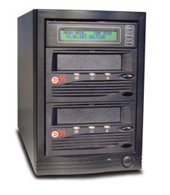
The TS Tape-Striping system is designed to speed up your writing to tape and lets you write to a maximum of five simultaneous tape-drives including 4mm, 8mm, AIT, DLT, SDLT, LTO, etc... People will also refer to this as Tape RAID-0 or Tape RAID level 0 or more accurately as RAIT (Redundant Array of Independent Tapes).
Striping mode provides faster backup by striping or writing the data across two (or more) tapes at the same time. Writing to two tape drives effectively doubles the effective drive transfer rate. Striping across more than 2 drives is also available (for 3, 4 and 5 drives) and naturally will speed-up writing to tape even more.
It provides "one button" intuitive menuing with an easy to read multi-line LCD control panel.
The TS tape-striping system can be used with any system platform such as UNIX, NT, MAC, or other platform and is completely transparent to the host system. The TS tape-striping system will make perfect copies every time. It doesn't matter to the TS tape-striping system what kind of backup software is being used, what type of system or OS the unit is attached-to, etc... the TS tape-striping system's job is to make sure all the data is transfered accurately onto the 2 to 5 tape drives of the unit.
Two Tape Striping

|
The TS tape-striping system must be connected to the host system via one 'connection'. All data is automatically striped to the various tape-drives via the internal striping controller.
The TS tape-striping system has features that make writing to multipe tape-drives simple and bullet proof: it can also write parity information on a parity drive (when more than 3 striping drives are utilized) - which is used to recover data if one of the tapes containing data cannot be read.
In the event of a drive or media failure, Read and write operations continue without interruption. This is also knows as Tape-RAID or RAIT where redundant data is written to an additional tape-drive providing protection in case of single drive failure.
Increased Performance
Data is striped across five independent parallel array channels. Data transfer rate, as well as search speed, is increased by as much as four times the speed of a single tape drive.
Increase Data Availability
Parity information stored on a parity drive is used to recover data if a tape containing data cannot be read. Read and write operations continue in the event of a drive or media failure.
Data Reconstruction
Recreates data previously written to a failed drive or bad media.
Data Scrambling
A high speed programmable switch matrix allows the insertion of the "stripe set tape cartridges" in any order for ease of tape management.
Graphical User Interface
The GUI (Optional) incorporates full, on-line and off-line controller configuration and diagnostics under Wind95 and NT operating systems..
Plug Compatibility
The striping tape array controller is presented to the host as a single SCSI tape drive providing "plug and play" with host systems supporting SCSI-1 and SCSI-2 tape protocols.
Robotics Support
Compatible with existing autoloader and library software in both striping and mirroring modes of operation.